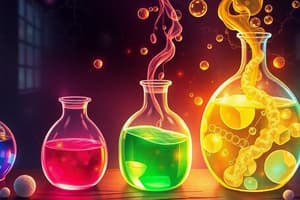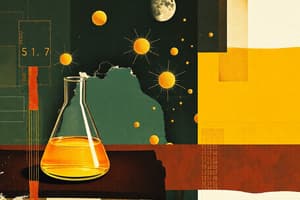Podcast
Questions and Answers
What happens to milk when left at room temperature during summers?
What happens to milk when left at room temperature during summers?
It spoils due to bacterial growth.
What is formed when magnesium burns in air?
What is formed when magnesium burns in air?
Magnesium oxide.
What are the signs that a chemical reaction has taken place?
What are the signs that a chemical reaction has taken place?
Change in state, change in colour, evolution of a gas, change in temperature.
Burning of magnesium ribbon is a physical change.
Burning of magnesium ribbon is a physical change.
What chemical reaction takes place when zinc granules are treated with acid?
What chemical reaction takes place when zinc granules are treated with acid?
The equation for the reaction of magnesium and oxygen is: Magnesium + Oxygen → _____
The equation for the reaction of magnesium and oxygen is: Magnesium + Oxygen → _____
What is the word-equation for the reaction between magnesium and oxygen?
What is the word-equation for the reaction between magnesium and oxygen?
Flashcards are hidden until you start studying
Study Notes
Overview of Chemical Reactions
- Chemical reactions occur when the nature and identity of substances change, evident in daily situations like milk spoilage, rusting, fermentation, cooking, digestion, and respiration.
- Differentiates physical changes from chemical changes, emphasizing that a chemical change signifies a chemical reaction.
Activities Demonstrating Chemical Reactions
-
Activity 1.1: Burning Magnesium
- A clean magnesium ribbon burns with a bright white flame, transforming into a white powder known as magnesium oxide.
- Reaction: Magnesium + Oxygen → Magnesium oxide.
-
Activity 1.2: Reaction of Lead Nitrate and Potassium Iodide
- Mixing lead nitrate with potassium iodide produces a visible reaction, leading to new products being formed.
-
Activity 1.3: Zinc with Dilute Acid
- Zinc granules react with either hydrochloric or sulfuric acid, triggering temperature changes and gas evolution.
Identifying Chemical Reactions
- Key indicators of a chemical reaction include:
- Change in state (solid, liquid, gas)
- Change in color
- Evolution of gas (bubbles)
- Change in temperature (exothermic or endothermic reactions)
Chemical Equations
- Chemical reactions can be expressed in word equations for simplicity.
- Example: "Magnesium + Oxygen → Magnesium oxide" records the reactants and products more succinctly.
- Reactants are the starting substances that undergo change, while products are the new substances formed.
Studying That Suits You
Use AI to generate personalized quizzes and flashcards to suit your learning preferences.





